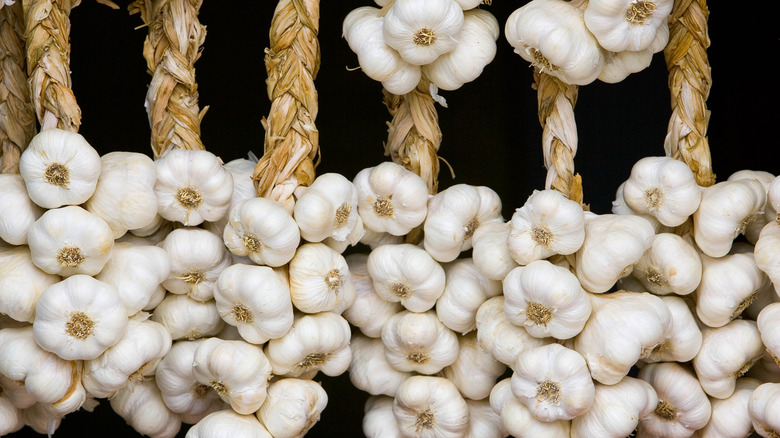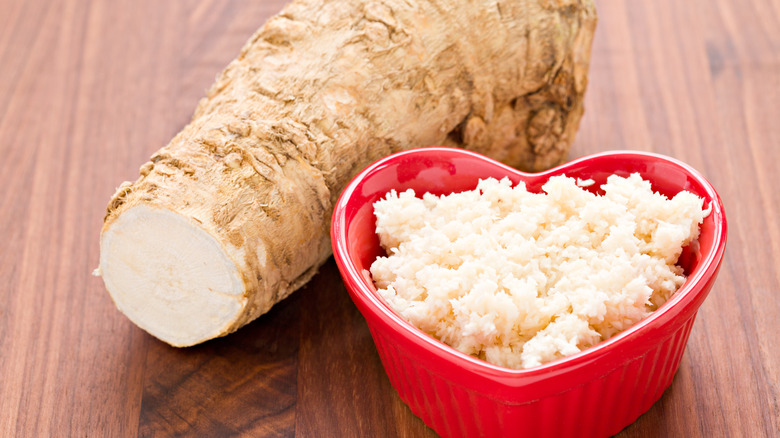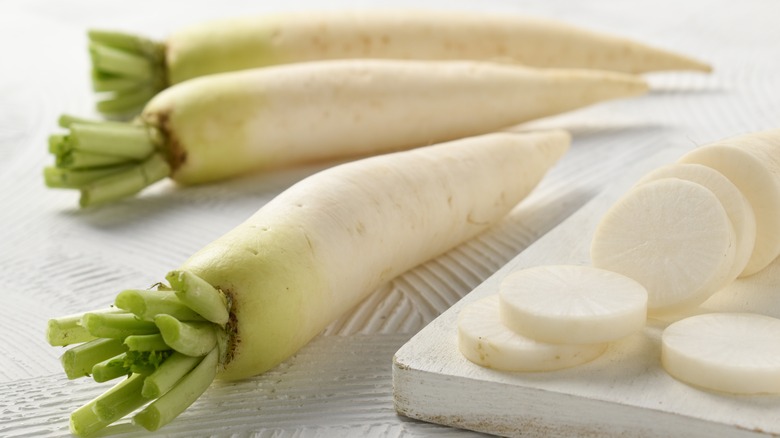The Pungent Ingredients To Give Deviled Eggs An Extra Zing Of Flavor
Deviled eggs have quite a reputation, earning a well-deserved spot in the pantheon of culinary classics. They show up on tables both fancy and humble, indoors and out, and in all seasons. According to professional egg associations as well as handed-down lore, a version of deviled eggs dates way back to ancient Rome where they got spiced up with sassy sauces for high-end gatherings. However, a Spanish tradition of pounding boiled egg yolks with fresh herbs and sauces comes a lot closer to what we eat today, especially because the yummy smashed yolks got slid back into scooped-out, egg-white "cups." Whatever the backstory, modern chefs have embraced the concept with secret slip-ins handed down from family to family.
Though always intended to have a bit of punch, like a mischievous kick from a friendly little devil, let's just be honest: deviled eggs can sometimes border on bland. That's why we need some pungent ingredients to give deviled eggs an extra zing of flavor. Those Spaniards way back in the 13th century had a good start with spunky cilantro, peppercorns, coriander, and onion juice. But having the entire culinary world at our fingertips these days, we could take things up a notch.
Here are a few ideas for bringing out the devil in those creamy egg treats. You can mix these pungent ingredients directly into the cooked yolk mixture, like a relish, or sprinkle or spread them as a garnish.
Minced garlic and garlic scapes
Fresh garlic is a classic example of potent pungency, especially when eaten raw. To really deepen the flavor complexity in deviled eggs, just peel and mince the cloves, and directly stir them into the boiled, mashed egg yolk. Take it higher on the pungency scale by grating the cloves instead of chopping them, which releases the allicin compound in garlic. If you prefer a more subtle nudge of garlic in your deviled eggs, sauté the former for a couple of minutes to lessen the impact. You'll still get a bit of bite with an added advantage of mild, nutty flavor.
Growing garlic in your garden or buying directly from a farmer's market will open up the option of harvesting the garlic scapes before the bulbs mature. These are the thin stems and buds growing out of garlic bulbs, which can add a different level of pungency that's more nuanced and earthy. You'd essentially use them the same way you would chives or green onions, by dicing and either stirring into the yolk or placing them prettily as a garnish for the grand presentation.
Horseradish brings the fire to deviled eggs
When it's time to toss out caution and let the fire roar, a small dollop of horseradish will light the flames. There are no worries about boring deviled eggs when bringing this spicy cruciferous veggie to the bonfire. We tend to consider horseradish a condiment, as it's typically used that way, but it's actually a root vegetable in the mustard family. Those long roots are where the pungency originates. Upon cutting, a sinigrin compound is broken down into a mustard oil, which provides the characteristic aroma and flavor.
Horseradish is certainly not shy about making its presence known. Unless tempered, it can be overwhelmingly present in the creamy yolk portion of your deviled eggs. You only need a pinky-dash at most to bring pizazz to the party. An alternative for the same perky flavor with less of a bite, consider horseradish sauce, which is the same root veggie, shredded and joined by mayonnaise, sour cream, or plain yogurt. Either version will seriously upgrade your deviled eggs.
Wasabi as a paste, sauce, or fresh garnish
Wasabi is often mistaken for horseradish, and there's a good reason that happens. This Japanese condiment takes a page directly from the horseradish story, with a green twist. What's known as wasabi in Western culinary circles and restaurants is actually just pungent horseradish that's ground into a paste and colored green. It's perfectly acceptable to use that version in deviled eggs, especially as it injects a festive green tint to deviled egg appetizers. But it's not genuine wasabi.
Though less common outside Japan, the real-deal wasabi plant is distinct from horseradish and carries an earthier nature. But make no mistake, this naturally green plant is full of vim and vigor. It needs no food dye to stand out in deviled eggs; The pungent aroma and peppery tones speak loud and clear.
The edible parts of the wasabi plant include its stalk, often referred to as the rhizome, which you can turn into a paste or sauce. Either works fine for mixing into your deviled eggs. The leaves and stems also make excellent garnishes when chopped or grated and sprinkled over the deviled eggs. The flavor diminishes rapidly once fresh wasabi is cut, so prepare it just prior to serving.
Ginger brings sassy, savory elements to deviled eggs
A darling of Thai, Asian, and Indian cooking, ginger is one of the least understood of the punchy pungent flavor bombs. Traditionalists may resist any notion of minced ginger entering the deviled eggs equation — until they try it. Ginger rolls all the sensory adjectives into a single tasty ball of piquancy; it's peppery, pungent, and spicy with a secret sweetness to keep things in check.
When employing ginger to kick up the heels of your deviled egg platter, you'll be using it pure, raw, and finely minced. The combo of ginger and minced garlic can take the place of relish in a typical deviled egg recipe. Though not quite as pungent, ground ginger is a fine stand-in for fresh minced garlic. Just go easy on the measurements; since it's a concentrated version, you'll only need about one-fourth the amount compared to its fresh counterpart. With ground or even roasted ginger, you'll get an energizing lift when dusting or dotting it over the finished deviled eggs.
Daikon radish for mild peppery tones
Daikon radishes have yet to take a star position in mainstream cooking, at least on Western dinner menus. That doesn't mean you should snub this tubular root veggie, which is highly popular in Japanese cuisine. Also known as a winter radish, the white daikon is more genteel than its bolder cousin, the red radish. It still brings its own snappy show tunes to the kitchen dance, just with a less boisterous personality. Daikon's flavor is milder, and its peppery tones are more subtle. However, they have a crispy, commanding presence in soft, creamy deviled eggs.
Like garlic and ginger, diced daikon is a viable substitute for pickle relish, perfect for adding crunchy texture to the otherwise routine yolks. They also carry a surprise hint of tangy sweetness. The small daikons are excellent options for deviled egg toppings, sliced paper thin and arranged like tiny flower petals unfolding over the oval-shaped stuffed beauties.
For even more presentation color, alternate daikon slices with Chinese watermelon radish. It hosts a crunchy green skin and pink inner flesh, with a milder flavor accentuating the more peppery daikon.





